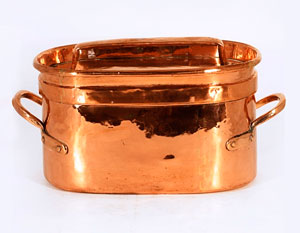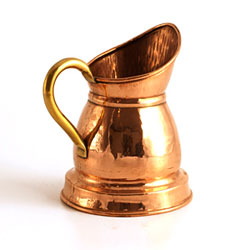Bringing New Life to Early Culinary Copper
 Copper fixed French braising pan. Late 18th to early 19th century.
Copper fixed French braising pan. Late 18th to early 19th century.Photograph courtesy of Virginia Tuttle
Virginia Tuttle's affinity for copper cookware was cultivated during the thirty years she spent as a curator at the National Gallery of Art in Washington, D.C. when she was given the opportunity to travel frequently to conduct research.
"I traveled to Europe and there I was collecting antique copper cookware," Tuttle says, adding much time was spent in France.
After retiring from the museum three years ago, Tuttle moved to Maine and decided to turn her love into a business of sorts.
"I am supporting my collecting habit," she says.
Her website, which is the sole platform for her business named Four-and-Twenty Blackbirds Kitchen Antiques, gives her the opportunity to showcase her finds. Scarcity, quality and condition dictate the price of each item in most cases, with her cookware ranging from approximately $100 to $1,000.
Tuttle describes the experience of holding a 100 year-old copper pot with a wrought iron handle with a brazed seam, bearing an insignia.
"It is really special," she says. "If you love history and you are subject to that sort of romantic feeling, using a very early copper pot is really exciting."
While pots are rarely dated, occasionally it will bare the name of the manufacturer, which makes it easier to pinpoint its date of origin.
"Then you can go to business directories and find out when they were in business," she says.
 19th century copper French pitcher.
19th century copper French pitcher.Photograph courtesy of Virginia Tuttle
Tuttle has come across some of her most prized finds when least expecting it.
"I can be in a rundown town in Maine, just out and about killing time somewhere and come upon an antique store," she says. "I have found the most incredible things."
Until recently, Tuttle focused on collecting English and French copper cookware.
"I found the French copper was the most spectacular," she says. "They were the most inventive with form."
Given the culinary expertise associated with France, Tuttle described how the copper cookware they created evolved with their culinary history.
The allure for cooks is the ability for copper to quickly conduct and spread heat throughout the pan creating no hot spots. In addition, the pan's heat quickly dissipates as soon as it is removed from the heat source.
Prior to the 18th century Tuttle explained there was little copper available due to shallow mines leading to unalloyed copper rarely being used for cookware.
The once thick, handmade copper pots made by artisans, in time, were largely replaced with the improvement of rolling technology, which led to less expensive and less preferred thinner pots.
Aside from serving the primary purpose of cooking food, the ownership of copper pots ran deeper in the late 18th and 19th centuries.
"It was a great status symbol certainly in England. It was something that one had to have," Tuttle says.
Pots bearing insignias and initials was commonplace, serving the purpose of ownership to keep the pots safe from sticky-fingered staff as well as to enable the tinsmith an easy way to keep track of pots he was re-tinning.
"The royalty would put a crown on it and an initial."
Her latest interest relates to copper and its relationship to social mobility in America during the Industrial Revolution. Tuttle finds copper cookware that started to be manufactured in the U.S. in the mid to late 19th century is difficult to find.
From auctions and estate sales to antique shops, Tuttle's passion for copper is known which gives her an advantage.
"I know enough dealers and enough know me -- it is relatively easy for me to collect," she says.
Resources:
Also in this Issue:
- Continuing the Copper Legacy of Roycroft
- Bringing New Life to Early Culinary Copper
- The Lure of Curiously Historic Coins Minted from Copper
- Copperton Lane: Specializing in Antique to Mid-Century Copper Items
- Princeton University of Art Unveils Monumental Bronze Sculptures by Ai Weiwei
